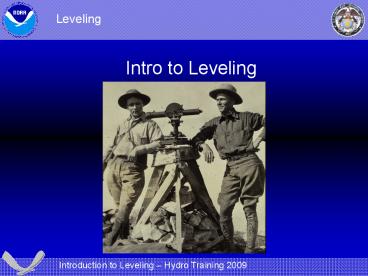Intro to Leveling PowerPoint PPT Presentation
Title: Intro to Leveling
1
Leveling
- Intro to Leveling
2
Why do we level?
- To determine elevation with respect to an
imaginary level surface (geoid) - Leveling allows you to tie the depths acquired
with the sonar to the geoid
3
Leveling
4
Equipment
- Level An instrument used for measuring vertical
distances
5
Compensated level
6
Level rod
A long brightly painted rod, accurately
calibrated in metric units (or feet and inches),
used for obtaining elevations and stadia
measurements of distance in mapping with a major
surveying instrument.
7
Leveling terminology
Backsight - reading on a rod that is held on a
point whose elevation has been previously
determined
Foresight - reading on a rod that is held at a
point whose elevation is to be determined
BM A
BM B
8
Leveling terminology cont.
Turning point - a temporary point whose elevation
is determined by additions and subtractions of
backsights and foresights respectively.
BM B
BM A
9
Leveling terminology cont.
Bust Error is outside of tolerance for
comparison of the forward run to the backward
run Blunder Gross error caused by human
mistake Thread Interval- Difference between upper
thread and middle thread, lower thread and middle
thread Thread error- Inaccurate reading of rod
resulting in greater than 2mm difference between
thread interval
10
- SAMPLE ROD READING
TOP THREAD MIDDLE THREAD BOTTOM THREAD
1048 1003 0960
0937 0892 0848
1162 1118 1072
11
10
09
Note Tread interval from top to middle 45 and
middle to bottom 43. Ideally, the thread
intervals should be equal, however this seldom
occurs in the field. Thread intervals for 3rd
order levels should match within 2 therefore,
this would be an acceptable reading.
08
11
Importance of balancing
3 3 0
12
Birds eye view of a standard level run
Forward Run
Backward Run
-5
5
SPUR
SPUR
-5
5
2
2
-4
-2
-2
-3
4
3
13
Birds eye view of a RAINIER level run
Forward Run
Backward Run
-5
5
SPUR
SPUR
-5
5
2
2
-4
-2
-2
-3
4
3
14
Sample Level Run
_
BS
FS
2
2
TP
_
TP
BS
FS
3
1
The difference in elevation 0 (-2) 1 -1 m
_
BS
FS
2
1
What is the difference in elevation between BM A
and BM B?
BM B is 1 m below BM A
BM A
BM B
Difference in Elevation -2 m
Difference in Elevation 1 m
UNBALANCED
15
Error
16
Parallax
17
Collimation
Collimation the accuracy of the alignment of
the optics of the level. Poor collimation will
result in gross errors and possibly a bust.
18
Kukkamaki setup
Allow instruments to acclimate to ambient
temperature for at least 10 minutes!!
10m
10m
20m
20m
19
Paper Kukkamaki - Collimation Check
Kukkamaki
1
where
)
Difference h Height BS
Backsight FS Foresight C Collimation Error
Instrument SN Rod SN Party
Chief Observer Recorder
Rod Person
20
Kahului
161 5680
1 1
No 9 196
2 1929
11/24/98
1620 1548 1477
1724 1654 1583
4961 mm
4645 mm
1628 1553 1480
1649 1569 1490
4708 mm
4661 mm
9353 mm
FS
9622 mm
BS
BS - FS
9.622 m - 9.353 m
0.289 m 0.302 m 0.591 m x
333 196.803 m 1000 0.196 km
Tip for Quick Mean
0.269 m
)
3
Stadia
0.08966 m
check
- (FORWARD RUN BACKWARD RUN)
0.0897 m - 0.0907 m 0.0010 m 0.20 km
Always use smallest distance
21
1668 1592 1518 4778 mm 1612 1542 1471 4625
mm 1722 1716 1711 5149 mm
1692 1612 1532 4836 mm 1562 1489 1417 4468
mm 1664 1659 1653 4976 mm
14552.0 mm
14280.0 mm
BS - FS
14.280 m - 14.552 m 0.272 m
3 - 0.09067 m
4.7600 - 4.8507 - 0.0907 m
0.316 m 0.302 m 0.618 m x
333 205.784 m 1000 0.205 km
)
Stadia
)
check
22
Newiz
Paper leveling made easy!
23
Run

